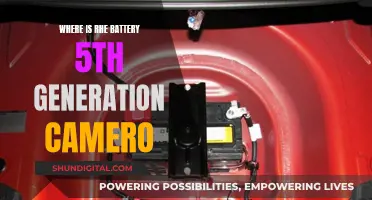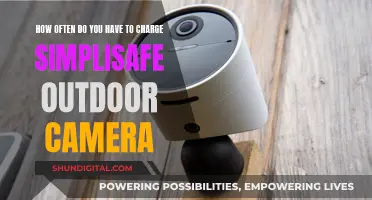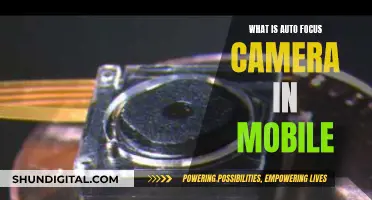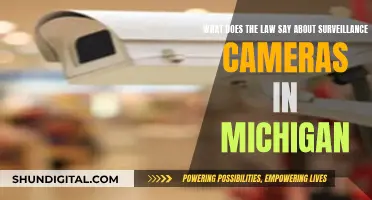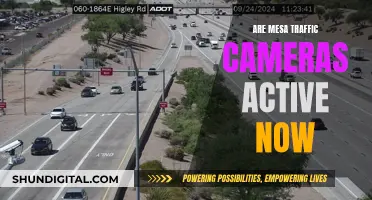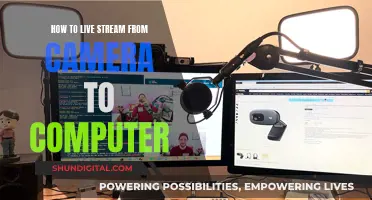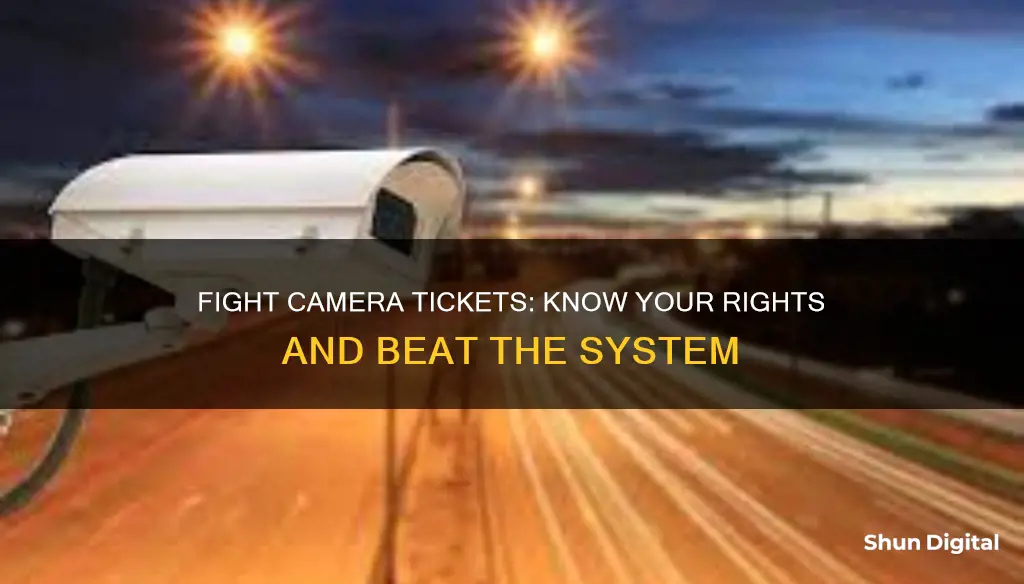
Fighting a camera ticket can be a tedious process, but it's not impossible. The first step is to examine your ticket and check the date, time, and location. Since camera tickets are sent to the owner of the car, make sure you were driving the car when the ticket was issued. If not, the prosecutor must prove that you were driving in that location at that date and time. If someone else borrowed your car, you cannot be prosecuted. However, some states treat red-light camera tickets like parking violations, holding the registered owner liable. Therefore, it is important to check the red-light law in the jurisdiction where you received the ticket. If you were driving, try to remember the details of the incident and write them down. For example, you may have been making a legal right turn on a red light, which could get the ticket dismissed.
The next step is to review the photos and videos that were taken by the camera. If the photos are blurry and your license plate or face is not clearly visible, this can be used as a defence. Additionally, if the photos do not show a clear violation, such as crossing the limit line or entering the intersection after the light turned red, there is no proof that you violated the law. It is also important to review the applicable laws and research any cases in your city or county about traffic cameras. There may be recognised defences that you can use, such as the necessity defence for speeding or the requirement for clearly visible warning signs for cameras.
To fight the ticket, you will need to plead not guilty and request a formal hearing. This can usually be done by mail or online, but sometimes an appearance in traffic court is required. During the hearing, you will need to present your case and any evidence that supports your claim. This could include photos, videos, or witness testimonies. It is important to remain respectful towards the judge and courthouse staff and to be organised and professional during the hearing.
| Characteristics | Values |
|---|---|
| Check ticket details | Date, time, location, driver, owner |
| Plead not guilty | By mail, online, or in court |
| Research law | Applicable law, cases, defences |
| Evidence | Photos, videos, maintenance records, warning signs |
| Defence strategies | Blurry photo, no proof of driving, camera unreliability, hearsay |
What You'll Learn

Check the ticket details and driver identity
Checking the ticket details and driver identity is a crucial step in fighting a camera ticket. Here's a detailed guide to help you through the process:
Check All Paperwork and Associated Details:
Firstly, examine the ticket and all associated paperwork thoroughly. Ensure that your name, address, and other personal details are correct and accurately spelled. Fraud and identity theft are prevalent, and con artists may send falsified tickets to obtain personal information. Contact the relevant agency to verify the authenticity of the ticket and citation number.
Understand the Arraignment Process:
The arraignment is not a court hearing but rather the opportunity to enter a plea of guilty, not guilty, or guilty with explanation. This plea will determine the next steps in your case. If you plead not guilty, a date for a court hearing will be set. Understand the court procedures and the potential consequences of your plea.
Verify You Were Driving:
Since camera tickets are usually sent to the vehicle owner, confirm that you were driving when the ticket was issued. The prosecution must prove that you were driving at the specified date, time, and location. If someone else was driving, you may not be prosecuted. However, some states, like New York, treat red-light camera tickets as parking violations, holding the registered owner liable.
Review Photographs and Videos:
Carefully review any photographs and videos included with the ticket. Confirm that the vehicle in the images matches your car and license plate. Blurry or unclear photos, especially those that don't clearly identify the driver, can be grounds for dismissal. Additionally, check if the photos show any legal maneuvers, such as a legal right turn on a red light, which could help get the ticket dismissed.
Request Additional Evidence:
If photos or videos are not included, you may need to request them from law enforcement after your trial is scheduled. You can also request maintenance records for the camera, traffic light, and speed monitoring system to establish their accuracy and reliability. Any discrepancies or lack of maintenance could cast doubt on the evidence.
Simplisafe Cameras: Battery-Powered or Direct Plug-in?
You may want to see also

Plead not guilty
If you want to fight a camera ticket, you must plead not guilty. Here is a step-by-step guide on how to do this:
Step 1: Check your ticket
Check the date, time, and location of the ticket. As camera tickets are sent to the owner of the car, make sure that you were the one driving when the ticket was issued. In most states, the driver (rather than the owner) is liable for the violation. However, some states, like New York, treat red-light camera tickets like parking violations, holding the owner responsible.
Step 2: Make a note of the exact code section
Read the law and understand the elements and penalties for violation. Remember, it is the prosecution's burden to prove each element of the violation, not yours to prove that you didn't do it.
Step 3: Review the photos
If your notification included photos, review them to confirm that it is your car in the photo and that the photo is clear. Blurry photos that don't clearly show your license plate or you in the driver's seat may be grounds for dismissal.
Step 4: Plead not guilty
You must plead not guilty if you want to dispute the ticket. You can do this by mail, online, or in-person at an arraignment. Check your citation and make sure you plead not guilty before the deadline, which is typically within 30 days of receiving the ticket.
Step 5: Request a formal hearing
When you plead not guilty, demand a full formal hearing or trial. This may require you to attend other hearings, such as pre-trial hearings or mediations, but don't accept anything less than a full dismissal of your ticket.
Step 6: Request production of documents
Call the local police department or law enforcement agency in charge of the camera and request copies of the photos if they were not included with your citation. Also, request full maintenance records for the camera and traffic light or speed monitoring system to establish that they were regularly monitored and maintained.
Step 7: Research the applicable law
Look for cases in your city or county about traffic cameras and see if any appellate court decisions have ruled on the legality of traffic camera tickets. For example, some states have specific rules about where warning signs must be posted for cameras, and if these signs were obscured or not present, you may have a defence.
Who Created the First JSH04 Camera?
You may want to see also

Research the law and build a defence
The first step in fighting a camera ticket is to carefully examine the ticket and all associated paperwork. Check for any signs of fraud or identity theft, such as incorrect or missing information. Contact the agency that issued the ticket to verify its authenticity. Note the court date and address provided on the ticket.
Next, research the specific laws and regulations related to camera tickets in your area. Understand the legal requirements and potential penalties for the violation. Familiarize yourself with any technical requirements, such as the need for warning signs before a traffic light. If any of these requirements have not been met, you may have grounds for dismissal.
Review any photos or videos included with the ticket to confirm that they show your vehicle and that the violation occurred. If the images are blurry or unclear, this may be a valid defence. Check if the license plate in the photo matches your car. If not, you may be able to get the ticket dismissed.
If photos are not included with the ticket, request copies from the local police department or law enforcement agency. You can also request maintenance records for the camera and traffic light system to establish that they were properly maintained and calibrated. Inaccuracies in the equipment's maintenance records may also provide a defence.
Finally, prepare a formal appeal, clearly stating why you believe the ticket is unjust and providing any supporting evidence. Submit your appeal and supporting documentation by mail or the specified online portal. Keep a copy of all submitted materials for your records.
Olympus Pen Camera Battery: Charging Time Explained
You may want to see also

Challenge the admissibility of the photo
To challenge the admissibility of a photo or video, it must meet two basic requirements: relevance and authenticity. Evidence is relevant if it has probative value, meaning it either supports or undermines the truth of any point at issue in the legal proceedings. Evidence is authentic if it accurately represents its subject matter as related to the legal claim. For example, a photo used as evidence in a traffic camera ticket case must truthfully represent the conditions of the road at the time and date of the incident.
- Undue prejudice: Argue that the photo evidence does not reasonably represent its subject and may result in undue prejudice.
- Hearsay: If there is no witness present for cross-examination, argue that the substance of the photo evidence is hearsay. In some jurisdictions, such as Broward County, Florida, a red-light camera photo is considered hearsay.
- The Best Evidence Rule: If the photo is a copy or facsimile, argue that the original is superior evidence.
- Lack of foundation: If visibility, time of day, weather, or other factors are at issue, question the substantial similarity between the incident and the photo evidence. For example, if the photo is blurry and it is difficult to identify the driver or license plate, this may be grounds for dismissal.
- Confrontation Clause: The Sixth Amendment of the Constitution guarantees the right to cross-examine witnesses. Unless a witness appears who maintains the record and system associated with the camera, you do not have this opportunity.
Solar Power for Your Swann Cameras: A Guide
You may want to see also

Argue the lack of evidence
When fighting a camera ticket, it's important to remember that the burden of proof is on the prosecution. They must prove that you were driving in the location at the date and time of the ticket. If you weren't driving, you can't be prosecuted.
If you were driving, you can still argue that the prosecution can't prove it was you driving the car, especially if there is no clearly identifiable photo of you in the driver's seat.
You can also argue that the camera equipment was faulty. Request the full maintenance records for the camera and the traffic light or speed monitoring system. If their accuracy wasn't tested shortly before your ticket was issued, the photo may be deemed unreliable as evidence.
If you are the registered owner of the vehicle but were not driving when the violation occurred, you can submit an affidavit swearing that you were not driving. This will generally result in the dismissal of the ticket.
Smoke Detector Camera Batteries: How Long Do They Really Last?
You may want to see also
Frequently asked questions
Some common defences include proving that someone else was driving the vehicle, arguing that the camera malfunctioned, or demonstrating that you had to run the red light due to an emergency situation.
Firstly, don't panic. You have the right to plead your innocence and fight the ticket in traffic court. Review the photos and videos provided with the ticket, and check the applicable state laws regarding red-light camera tickets.
You can plead not guilty by responding to the citation either by mail or online, or by appearing at an arraignment and entering your plea. This will result in a formal hearing or trial, where you can present your defence.
The penalties vary by state. In some states, the fines are similar to those for non-camera traffic violations, ranging from $75 to $400. In other states, the fines are lower, typically $100 or less. Red-light camera tickets also differ in whether they add demerit points to your driving record or affect your insurance rates.


